(Shopping for Plum ski touring bindings can be a challenge due to poor North American distribution. Readers, please share your shopping links in the comments.)
Lightweight, reliable, a resistance-free touring pivot, and no lifted weight on each touring stride: yes, an AT binding breakthrough.
I’m talking of course about the original Dynafit bindings that came on the scene about two decades ago. Hard to improve upon the original, and even the late 90s TLT IV still lives on virtually unchanged in the form of the Dynafit Speed model. The Vertical ST (10) and FT12 offer some improvements, although for many skiers even the original Speed is still preferable. Note though that for the 2011-12 season Dynafit is introducing the new “Radical” variations of its Speed, ST, and FT12 models with what appear to be more significant modifications, although I suspect skier opinion will diverge on the utility of some of the modifications.
So, can Plum improve upon Dynafit’s fundamental design? My personal impression so far is that new Guide binding combines the best of all worlds, i.e., Speed, Vertical ST/FT, and even some of the upcoming features on the new Radical variations. But read on and decide for yourself.
First off, the Guide model is aimed straight at those users interested in the Speed and Vertical ST10/FT12. By contrast, the G3 Onyx/Ruby with its extra plastic, moving parts, and weight has always struck me as aimed more toward the Diamir set or other skiers reluctant to take the Dynafit conversion. And the new ATK RT is somewhat of a hybrid between the Speed and more race-oriented models.
As summarized in my prior preview, the Guide essentially offers the weight of the Dynafit Speed with a 30mm fore/aft adjustment range that is a bit longer than the Dynafit Vertical and a 5.5-12 release value range that is similar to the FT12. (Note that the imprinted adjustment range for lateral and forward release values — respectively — measures out to approximately 5.1/5.7 for the ST, 5.6/5.8 for the FT12, and 6.2/7.4 for the Guide. The variations are very difficult to measure precisely, but bottomline is that FT12 has a slightly longer compression range than the ST, while the Guide is noticeably longer.) Plum also offers a version that has a much lower 3-7 release value range, plus a version of each release value range that eliminates the highest heel elevator position. A brake though will not be available until the following season, although a leash is included, weighing in at only half an ounce per pair.
And of all the new “Tech” competitors (with adjustable release values), the Guide is definitely closest in all aspects to Dynafit, so I’ll focus my review on a compare/contrast with different Dynafit models.
The very first impression is that although any new ski gear has its appeal, especially backcountry gear, and even more so any Dynafit or “Tech” binding, the Guide’s finish is of amazingly impressive quality. And if you put a high value on metal content in your ski bindings, then this is certainly the choice for you. Does that mean the Guide has enhanced durability? I can immediately identify some Dynafit failure modes that would seem to be addressed on the Guide, but only time will tell whether it has its own vulnerabilities, so at this point any speculation on durability is, yes, just speculation. (But since everyone is going to be asking about this recent failure, yes, the Guide base is fully supported laterally with no hanging extension, the metal is thicker in cross section, and the screws are set farther inside the metal base.)
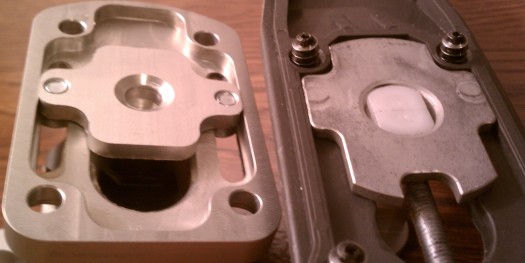
Guide pedestal base has thicker cross section, although small surface area. Guide is secured directly to metal rail (which in turn is screwed into ski), as opposed to Dynafit method of plastic baseplate pressing down on heel pedestal base.

Dynafit pedestal has threaded hole for screw adjustment, whereas Guide is held down at the sides. Guide thimble bushing is a bit easier to remove (perhaps because of the larger hole in the center), although the heel piece has a noticeably tighter fit on the pedestal. But those end caps sure look similar!
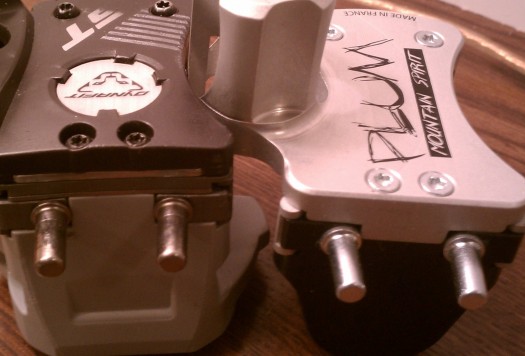
Guide top plate is metal and partially extends over the sides of the binding. All four Guide screws are flush with the top plate (as opposed to just two out of four for Dynafit).
But enough of the subjective evaluation, onto the digital postal scale you go! At 1 pound 8.6 ounces (with mounting screws), the Guide is essentially tied with the Dynafit Speed, so about six ounces of weight savings (per pair) over the Vertical brethren (or even far more compared to the upcoming Radical FT12 with its substantial toe-heel connector). For geometry, standheight off the ski and heel-toe “delta” is partway between the Speed and Vertical models (the latter having more of both) — whether this is good or bad all depends on your stance alignment needs. Heel elevator angles are virtually identical to the Speed, which is a bit less steep than the Vertical. And the heel elevator has a whopping four different ski pole insertion points.
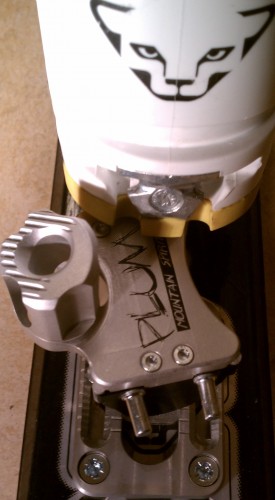
The Dynafit Snow Leopard ready to pounce on one of the four pole insertion points on the heel riser!
Mounting follows the classic Dynafit pattern, but without the fifth toe hole (which the Dynafit “Radical” line will also jettison for the 2011-12 season, while moving the two front toe holes forward by 6mm).
Adjusting the heel’s fore/aft position requires a T-25 driver, which is included with the binding, and which oddly enough just happens to be the other driver on the little Avid brake tool that includes a T-10 that fits the top plate screws (for both Dynafit and Plum). The boot-binding gap at the heel is set at 4mm (and the T-25 driver does double duty as a spacer shim), which combined with the Vertical’s pin length required some very minor grinding on the TLT5 rubber slots, since they inaccurately extend past the boot plastic, creating a little lip. (The TLT5 toe area also has excess rubber: mine just barely fit initially into my Dynafit bindings when I first used them, and others have reported mandatory trimming before use.)
Plum provided me with a detailed diagram demonstrating heel pin movement within the boot interface as a function of ski flexion, so they certainly seem to have thought through this combination (of heel pin length and boot-binding gap) in great detail. (And the release values are calibrated based upon the combination of 4mm gap, Vertical-style pin length, and hence greater pin penetration into the boot heel interface. In other words, although mechanically you could set up a Vertical binding to the same specs, doing so would put you into unknown territory for release values. More, as Lou has brought up probably 600 times, this movement of the pins changing release value on the fly is one reason why tech bindings are not certified to any sort of DIN/ISO safety release binding standard.)
As I wrote in my preview, a Dynafit binding’s utilization of the ski topskin as part of the binding has been eliminated, since the flat base of the Guide’s heel pedestal is screwed down directly to the mounting track (as opposed to be pressed down against the topskin by a separate plastic mounting plate), the butt end of the touring lock lever presses up against a hump on the binding frame (as opposed to any separate plastic mounting plate), and the ski crampon slot is part of the binding frame (once again as opposed to any separate plastic mounting plate).
Upon entry, the Plum toe lever is designed to flip automatically into tour ‘lock’ mode. I say “designed” because if the entry is a bit sloppy or gradual, then the toe lever doesn’t quite make it — this has happened about half the time on three separate outings with multiple transitions when I was entering the binding amidst two feet of fresh powder (which was nice compensation for having to reach down and pull up the lever). Indoors on a workshop mat, over several trials my success rate was 100%. And unlike race bindings with such automatic entry, the toe lever can then be pressed down for ski mode (rumor has it that all bindings will eventually have that feature, due to rando racing rule changes).
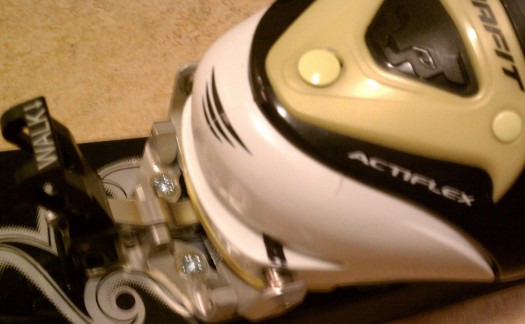
Toe lever is designed to go in tour mode automatically upon entry, but can be pushed back down for ski mode. That is of course a feature that many of our readers here want in their tech bindings.
So how does the Plum Guide perform for actually, well skiing? As far as I can tell in the field, just fine, but of course I had to devise some indoor tests in an attempt to quantify their performance. For the rigidity of the boot-ski coupling, I swung the lever arm of my ski binding torque tester out to the side and added a 12.7-pound weight, then measured the angle of the boot deflection. Similar to Lou’s deflection test, this fails to account for the downward vector of a skier on top of the bindings, and probably also had more ski movement than with Lou’s setup. Nevertheless, the measured angles for various Dynafit models vs. the Guide were almost identical. (The Plum race binding showed about another degree of deflection.) One difference I did note was that with the Dynafit models the heel unit was clearly deflecting to some extent, whereas with the Guide the heel unit was impressively unaffected, yet the boot then just moved more relative to the binding (given the tolerances of any “Tech” heel pins within the standard boot interface).
Okay, now perhaps the most important for last: Dynafit and its “Tech” competitors in touring bindings (i.e., with adjustable release values) attempt to use one-size-fits-all toe springs, which face a difficult task of retaining you when the heel pins are engaged yet releasing you once the heel pins are disengaged (whether because of a lateral or forward release at the heel). The Merelli R8 Evolution race binding achieves adjustable tension via adding or subtracting washers, similar to an experiment that Lou conducted. G3 also claims to have stronger toe retention, due both to stiffer springs as well as slightly different geometry of the toe wings.
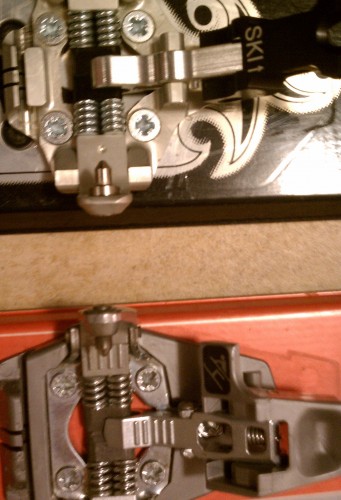
Toe springs seem to be same thickness as Dynafit (with the exception of 2011 wide brake FT12), but are packed closer together.
So how does the Plum Guide compare in toe spring pressure? Well, first off, I suspect that retention characteristics are a function of not only spring pressure but also exact geometry of the toe wings along with the pincer span. For the latter, when closed (without a ski boot) the Guide is about half a millimeter wider as compared to current Dynafit models, although this could be my own measurement variance or just manufacturing variations. For measuring toe spring pressure, I don’t have an accurate measurement method yet, although the Guide springs seem packed together more closely as compared to a Dynafit, which has some small spacing between each coil. For the 2011-12 season, Dynafit debuts the “Power Towers” on its Radical bindings, which are claimed to help eliminate pre-release while also enhancing ease of entry. Innovative for sure, but efficacy is of course still entirely unknown. (That does bring up my one little quibble with the Guide: when the heel unit is rotated 90 degrees clockwise, and I put my boot heel flush up against the heel unit housing, I feel like the boot toe interface is about 1mm back from the ideal position for clicking into the binding toe pincers. But the alignment still enhances entry, although with the TLT5 quick step-in interface, pretty much any approach works well.)
(WildSnow guest blogger Jonathan Shefftz lives with his wife and daughter in Western Massachusetts, where he is a member of the Northfield Mountain and Thunderbolt / Mt Greylock ski patrols. Formerly an NCAA alpine race coach, he has broken free from his prior dependence on mechanized ascension to become far more enamored of self-propelled forms of skiing. He is an AIARE-qualified instructor, NSP avalanche instructor, and contributor to the American Avalanche Association’s The Avalanche Review. When he is not searching out elusive freshies in Southern New England or promoting the NE Rando Race Series, he works as a financial economics consultant.)
WildSnow guest blogger Jonathan Shefftz lives with his wife and daughter in Western Massachusetts, where he is a member of the Northfield Mountain and Thunderbolt (Mt. Greylock) ski patrols. Formerly an NCAA alpine race coach, he has broken free from his prior dependence on mechanized ascension to become far more enamored of self-propelled forms of skiing. He is an AIARE-qualified instructor, NSP avalanche safety instructor, and contributor to the American Avalanche Association’s The Avalanche Review. When he is not searching out elusive freshies in Southern New England, he works as a financial economics consultant.
